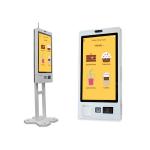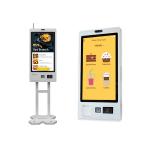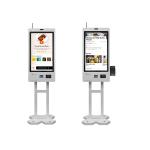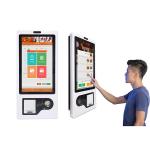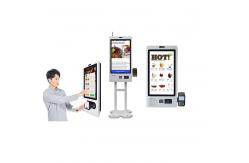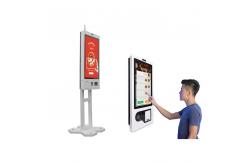Exterior:
The appearance of self-service ordering machines usually adopts a
simple and modern design style, with basic components such as
screens, buttons or touch screens, and payment devices. The housing
material is usually durable metal or plastic with a smooth surface
that is easy to clean.
Features:
1. Autonomy: Customers can choose their own dishes without relying
on waiters, which improves the autonomy and convenience of dining.
2. Speed: The self-service ordering machine is simple and fast to
operate, saving customers time waiting for service and improving
dining efficiency.
3. Accuracy: Through the electronic ordering process, human errors
are reduced and order accuracy is improved.
4. Personalization: Support personalized customization to meet
customers' personalized taste needs and improve customer
satisfaction.
5. Cost savings: Labor costs are reduced. Merchants can realize
automated services through self-service ordering machines, reducing
operating costs.
6. Data analysis: Order data can be analyzed through the backend
management system to understand customer consumption habits and
dish popularity, providing reference for business decisions.
Technical Parameters:
Android system | CPU: RockChip RK3288 CORTEX-A17 Eight-Core CPU 1.8GHz
GPU: Mali-T764
O/S: Android 6.0
RAM: 2GB
NAND FLASH: 8GB FLASH/EMMC
Networking: RJ45/Built-in Wireless 802.11b/g/n,WAPI(Ralink 8188)
/USB Wireless Dongle
Interface:USB*4,SD*1,HD-MI*1,RJ45*1,Audio out*1,SIM port*1 ,RS232*2
Bluetooth:2.402GHz to 2.480GHz |
Panel | Brightness:350cd/m2
Maximum colors:16.7M
Response time:5ms
Backlight life:>50000 hrs
TP Type:Capacitive 10 point |
external device | Printer:58mm
QR code:Support(optional)
RFID:Support(optional)
camera:Support(optional) |
Other | Power Supply:Ac 110~240V 4A 50/60HZ
Power:45w MAX
Speaker:Built-in 2*8W high quality stereo loudspeakers
Sound Effects:yes
Work Temperature:-10°C-60°C
Storage Temperature: -20°C-70°C
Working Humidity:20%-80%
Storage Humidity:10%-95% |
Advantage:
1. Improve service level: Self-service ordering machines provide a
more convenient and efficient dining experience, improving the
overall service level of the restaurant.
2. Reduce queuing time: Customers can choose dishes and complete
payment independently, reducing queuing time for manual services.
3. Reduce the order error rate: The electronic ordering process
reduces the interference of human factors and reduces the order
error rate.
4. Save labor costs: Self-service ordering machines can replace
some of the waiters' work, reducing labor costs.
5. Increase order flow: It provides a more convenient way to order
food, attracting more customers to choose this restaurant to dine,
and increasing order flow.
Application scenarios:
Fast food chain stores: Suitable for fast-paced fast food
environments, providing fast and convenient dining services.
Buffet restaurant: Customers can choose dishes and portions
according to their personal preferences, and mix them freely, which
increases the flexibility of dining.
Restaurant queuing to order: During peak hours, customers can queue
to order through self-service ordering machines to reduce queuing
waiting time.
Cafes and tea restaurants: Provide ordering, payment and other
services to facilitate customers to choose various coffee or tea
drinks.
Corporate canteens and school canteens: Provide a variety of dining
options to meet the taste needs of different groups of people,
reduce queuing time, and improve dining efficiency.

